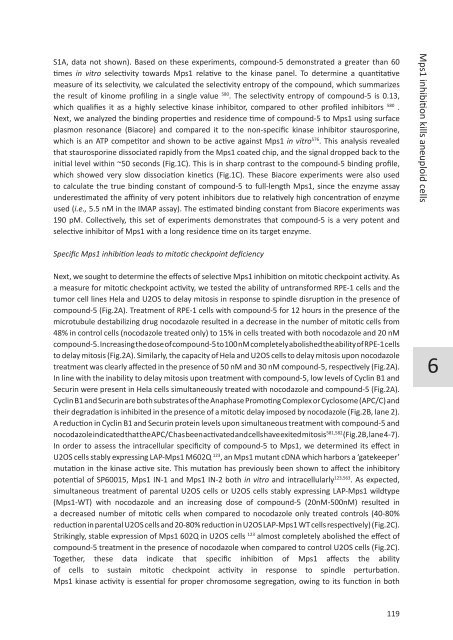Chromosome segregation errors: a double-edged sword - TI Pharma
Chromosome segregation errors: a double-edged sword - TI Pharma
Chromosome segregation errors: a double-edged sword - TI Pharma
You also want an ePaper? Increase the reach of your titles
YUMPU automatically turns print PDFs into web optimized ePapers that Google loves.
S1A, data not shown). Based on these experiments, compound-5 demonstrated a greater than 60<br />
times in vitro selectivity towards Mps1 relative to the kinase panel. To determine a quantitative<br />
measure of its selectivity, we calculated the selectivity entropy of the compound, which summarizes<br />
the result of kinome profiling in a single value 580 . The selectivity entropy of compound-5 is 0.13,<br />
which qualifies it as a highly selective kinase inhibitor, compared to other profiled inhibitors 580 .<br />
Next, we analyzed the binding properties and residence time of compound-5 to Mps1 using surface<br />
plasmon resonance (Biacore) and compared it to the non-specific kinase inhibitor staurosporine,<br />
which is an ATP competitor and shown to be active against Mps1 in vitro 576 . This analysis revealed<br />
that staurosporine dissociated rapidly from the Mps1 coated chip, and the signal dropped back to the<br />
initial level within ~50 seconds (Fig.1C). This is in sharp contrast to the compound-5 binding profile,<br />
which showed very slow dissociation kinetics (Fig.1C). These Biacore experiments were also used<br />
to calculate the true binding constant of compound-5 to full-length Mps1, since the enzyme assay<br />
underestimated the affinity of very potent inhibitors due to relatively high concentration of enzyme<br />
used (i.e., 5.5 nM in the IMAP assay). The estimated binding constant from Biacore experiments was<br />
190 pM. Collectively, this set of experiments demonstrates that compound-5 is a very potent and<br />
selective inhibitor of Mps1 with a long residence time on its target enzyme.<br />
Specific Mps1 inhibition leads to mitotic checkpoint deficiency<br />
Next, we sought to determine the effects of selective Mps1 inhibition on mitotic checkpoint activity. As<br />
a measure for mitotic checkpoint activity, we tested the ability of untransformed RPE-1 cells and the<br />
tumor cell lines Hela and U2OS to delay mitosis in response to spindle disruption in the presence of<br />
compound-5 (Fig.2A). Treatment of RPE-1 cells with compound-5 for 12 hours in the presence of the<br />
microtubule destabilizing drug nocodazole resulted in a decrease in the number of mitotic cells from<br />
48% in control cells (nocodazole treated only) to 15% in cells treated with both nocodazole and 20 nM<br />
compound-5. Increasing the dose of compound-5 to 100 nM completely abolished the ability of RPE-1 cells<br />
to delay mitosis (Fig.2A). Similarly, the capacity of Hela and U2OS cells to delay mitosis upon nocodazole<br />
treatment was clearly affected in the presence of 50 nM and 30 nM compound-5, respectively (Fig.2A).<br />
In line with the inability to delay mitosis upon treatment with compound-5, low levels of Cyclin B1 and<br />
Securin were present in Hela cells simultaneously treated with nocodazole and compound-5 (Fig.2A).<br />
Cyclin B1 and Securin are both substrates of the Anaphase Promoting Complex or Cyclosome (APC/C) and<br />
their degradation is inhibited in the presence of a mitotic delay imposed by nocodazole (Fig.2B, lane 2).<br />
A reduction in Cyclin B1 and Securin protein levels upon simultaneous treatment with compound-5 and<br />
nocodazole indicated that the APC/C has been activated and cells have exited mitosis 581,582 (Fig.2B, lane 4-7).<br />
In order to assess the intracellular specificity of compound-5 to Mps1, we determined its effect in<br />
U2OS cells stably expressing LAP-Mps1 M602Q 123 , an Mps1 mutant cDNA which harbors a ‘gatekeeper’<br />
mutation in the kinase active site. This mutation has previously been shown to affect the inhibitory<br />
potential of SP60015, Mps1 IN-1 and Mps1 IN-2 both in vitro and intracellularly 123,563 . As expected,<br />
simultaneous treatment of parental U2OS cells or U2OS cells stably expressing LAP-Mps1 wildtype<br />
(Mps1-WT) with nocodazole and an increasing dose of compound-5 (20nM-500nM) resulted in<br />
a decreased number of mitotic cells when compared to nocodazole only treated controls (40-80%<br />
reduction in parental U2OS cells and 20-80% reduction in U2OS LAP-Mps1 WT cells respectively) (Fig.2C).<br />
Strikingly, stable expression of Mps1 602Q in U2OS cells 123 almost completely abolished the effect of<br />
compound-5 treatment in the presence of nocodazole when compared to control U2OS cells (Fig.2C).<br />
Together, these data indicate that specific inhibition of Mps1 affects the ability<br />
of cells to sustain mitotic checkpoint activity in response to spindle perturbation.<br />
Mps1 kinase activity is essential for proper chromosome <strong>segregation</strong>, owing to its function in both<br />
119<br />
Mps1 inhibition kills aneuploid cells<br />
6













